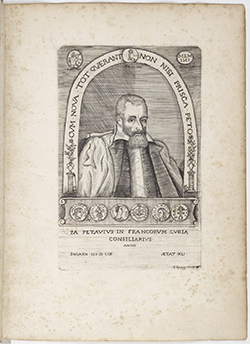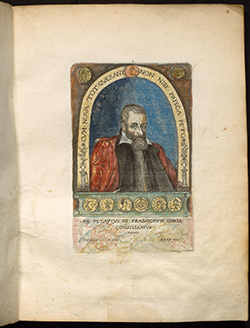François Rousset (17th ce.), Portrait of Paul Petau, 1609

Paris,Bibliothèque nationale de France, département Réserve des livres rares, RES-J-1346 (1), unnumberd, soon after the frontispiece
Bust-length portrait in three-quarter view, facing right. Petau is depicted at the age of 41 with the characteristic physiognomy: gaunt face, prominent cheekbones, wavy hair, slightly receding hairline, long full beard, and mustache. His head is slightly bent forward. He is wearing an elegant magistrate robe buttoned down the front with an open collar and a coat. The bust is in a semi-circular frame with a neutral background.
On the edge of the frame an inscription reads: CVM NOVA TOT QVӔRANT NON NISI PRISCA PETO. At the beginning and end of the inscription is a small column topped by a vase and racemes.
The upper two corners of the plate respectively house a gemstone, while a third (abraxas) is at the apex of the round arch.
Petau appears to be behind a windowed opening. In front of him, as a kind of spatial demarcation, on a cartouche, the obverse and reverse of three Merovingian gold coins are represented, respectively, two of them struck in his birthplace, Orléans.
Finally, on the lower margin of the plate there is another inscription wich reads:
PA. PETAVIVS IN FRANCORVM CVRIA / CONSILIARIVS / ANNO / INCARN M.DC.IX ӔTATIS XLI ӔTAT XLI.
In the lower right corner of the plate is the engraver's signature:
F. Rousset . sculp. + Paris
The portrait of 1609 is bound in some of the poorest copies (in term of number of plates) of the Portiuncula from the earliest period, around 1610, mainly at the beginning of the volume.

Paris, Institut de France, Bibliothèque Mazarine, 4° 16333 [Res], pl. 2r
Coloured copy: The magistrate's robe is depicted in black with an open white collar and red coat. The bust is in a semi-circular frame with a neutral blue background. The three gemstones are coloured to resemble the material from which they are made.
This plate with the Petau’s portrait is included in a partially colored specimen preserved at the Bibliothèque Mazarine in Paris. A second specimen with some colored plates is kept at the university library at the Sorbonne in Paris, but there the portrait was not painted.
